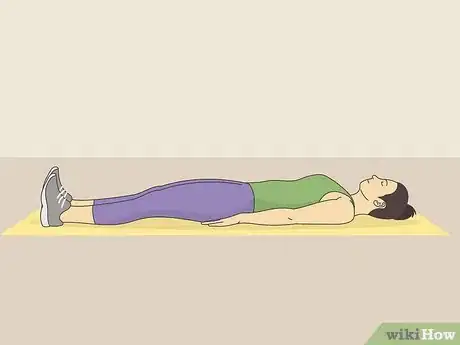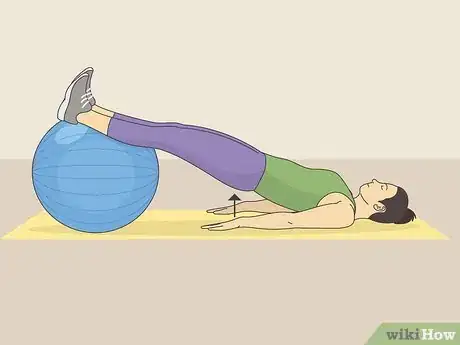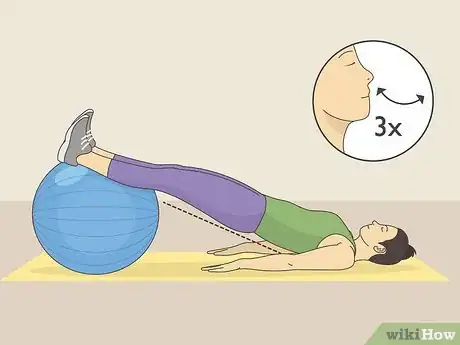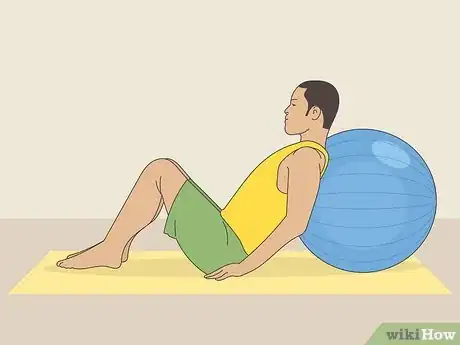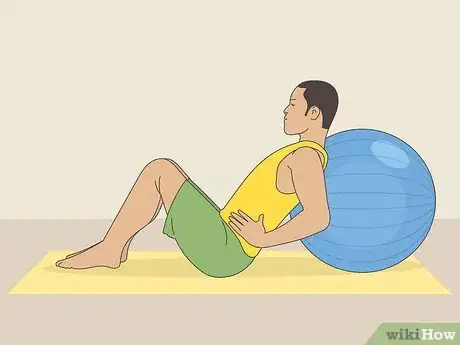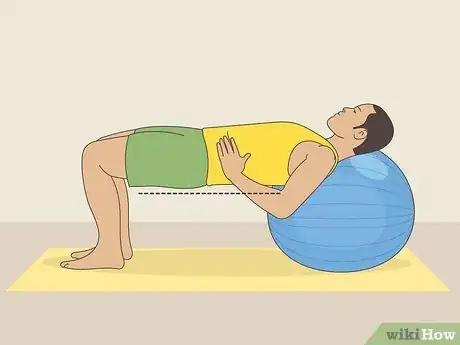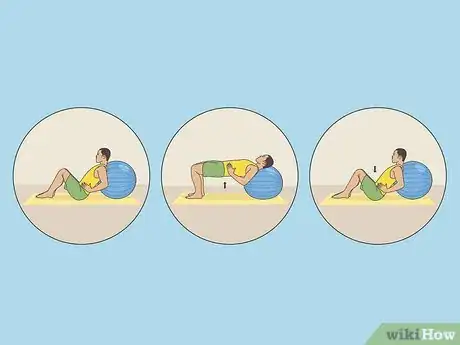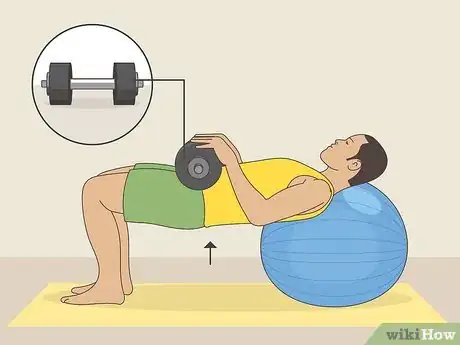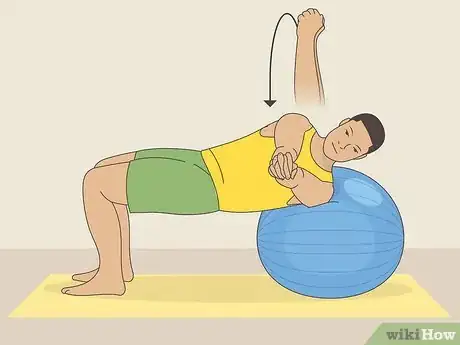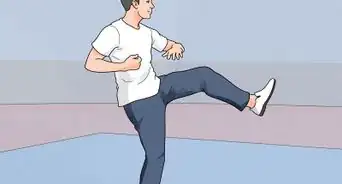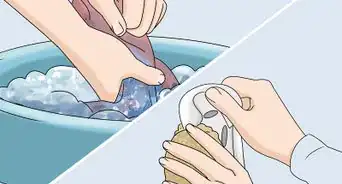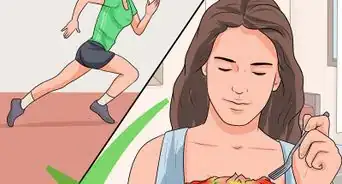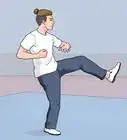This article was co-authored by Landis Owens and by wikiHow staff writer, Hunter Rising. Landis Owens is a Personal Trainer and the Owner of Almighty Personal Training Studio in Tempe, Arizona. With over 15 years of experience in the health and fitness industry, Landis specializes in weight loss, nutrition, and core and strength training. Landis received a football scholarship to Mesa Community College where he studied Engineering and Sports and Exercise. He is an ISSA Certified Personal Trainer and also holds certifications in Nutrition, Youth Sports, Injury Stay Free, and CPR. Landis also competes in bodybuilding competitions.
There are 19 references cited in this article, which can be found at the bottom of the page.
This article has been viewed 68,657 times.
Are you looking for a new glute and core exercise for your routine, but don’t want something too intense? If you have an exercise ball, bridges make a great addition to your workout! You can perform bridges by placing your legs or your back on the ball, but they work the same muscles so pick whatever position feels the most comfortable for you. We’ll walk you through how to properly do bridges for both positions along with a few variations to make your workout even more intense.
Steps
Bridges (Legs on Ball)
-
1Lie flat on your back. Try to do this exercise on a padded floor or lay out an exercise mat so you’re a little more comfortable. Lie down on your back and look straight up toward the ceiling.[1] Keep your arms at your sides so your palms are flat against the floor to help stabilize your body during the exercise.[2]
-
2Place your calves on top of the exercise ball. Lift your legs up and roll an exercise ball underneath them. Position the middle of your calves on top of the ball so you’re bending at the hips. Make sure you keep your lower back flat against the floor. Leave some room between your thighs and the ball so you can properly perform the exercise.[3]
- The exercise ball adds more resistance to the exercise so you develop better body control.[4]
- If you want to work your core even harder, only rest your feet on top of the exercise ball instead.
- Get an exercise ball that’s the proper size for your body. If you’re between 5’1”–5’7” (155–170 cm), get a 21 in (53 cm) ball. If you’re 5’8”–6’1” (173–185 cm), then get a ball that’s 25.5 in (65 cm). For people 6’1” (188 cm) or taller, get a 29.5 in (75 cm) ball.[5]
Advertisement -
3Lift your hips until your back and legs form a straight line. Take a deep breath in as you tighten your core muscles and your glutes. Press your legs into the exercise ball and slowly lift your hips off of the floor. Keep your head, arms, and shoulder blades against the floor. When your back makes a straight line with your thighs, stop and maintain your position.[6]
- Breathe freely the whole time you’re performing the exercise so you don’t hold your breath.[7]
- The exercise ball makes you less stable, so you engage your core and glute muscles even more to hold still. Make sure you go slowly when you’re first starting off so the ball doesn’t slip out or roll away.
-
4Hold your position for 3 deep breaths. Slowly take 3 deep breaths in and out and try to keep your body straight. Avoid letting your hips sag or arching your back since it could cause you to strain your muscles.[8]
- Even though you can use your arms to help stabilize yourself, don’t use them to completely balance yourself. Otherwise, you won’t work your core as much.
-
5Lower your hips back to your starting position. Using a slow and controlled motion, relax your muscles and drop your glutes back onto the floor. Try to keep the ball as still as possible as you lower your hips. Take a short rest between your reps so you don’t feel too fatigued.[9]
-
6Complete 3 sets that are each 10 reps for a full workout. During your first set, aim to do 10 full reps of your exercise, but don’t get discouraged if that’s too difficult. Even aiming for 5 reps is a great start.[10] Take a short break between your sets so your muscles have a chance to relax before starting your next one.[11]
- You should start to feel fatigued by the end of your last set, so don’t push yourself if you’re in pain or struggling to complete all your reps.
-
7Lift your arms off the floor to engage your core more. If you’re looking for an easy way to build your core muscles, try raising your arms 1–2 inches (2.5–5.1 cm) off of the floor or crossing them over your chest. Since you can’t press into the floor with your palms to stabilize yourself, your abs will work a lot harder to keep your body stable.[12]
-
8Lift 1 leg off of the ball to make the exercise more intense. If regular bridges start feeling too easy, try balancing on a single leg instead. Lie on the floor with the ball underneath your legs. Raise your left leg 1–2 inches (2.5–5.1 cm) off of the ball and try lifting your hips off the floor to get into the bridge position. Hold the pose for about 3 counts before lowering yourself back down.[13]
- Alternate your legs after each rep so you work both sides evenly.
-
9Roll the ball closer to you with your feet to work your core and hamstrings. Tighten your core muscles and glutes and push your hips up to straighten your back like you’re doing a regular bridge. Dig your heels into the ball and engage your hamstrings to roll the ball until your knees are bent to 90-degree angles. Hold your position for 3 counts before slowly rolling the ball back to the starting position and lowering your hips.[14]
- Try starting with your heels on the ball instead of your calves so it’s more of a challenge lifting your hips.
Bridges (Back on Ball)
-
1Sit on the floor with your shoulders against the exercise ball. Find a comfortable place to do your exercise, like on a mat or padded floor. Lie down so your feet are flat on the floor and slightly wider than shoulder-width. Position your exercise ball behind you and lean back against it. Only rest your upper back and shoulder blades on the ball, or else you won’t engage your core while you’re performing your exercise.[15]
- Keep your feet slightly wider than you would if you were doing a bridge exercise on the floor.[16]
- When you’re choosing an exercise ball, get a 21 in (53 cm) ball if you’re between 5’1”–5’7” (155–170 cm), a 25.5 in (65 cm) ball if you’re 5’8”–6’1” (173–185 cm), or a 29.5 in (75 cm) ball if you’re 6’1” (188 cm) or taller.[17]
-
2Place your hands on your sides or across your chest. Keep your arms tight against the sides of your body and put your hands on your hips. If that’s not very comfortable when you’re first starting off, just cross your arms in front of your chest so they’re not in your way.[18]
- Do not use your arms to push or lift yourself up during the exercise, or else it won’t work your core or glutes as well.
-
3Lift your hips so your thighs and back form a straight line. Take deep breaths the entire time you’re performing the exercise. When you’re ready to start, engage your core and glutes. Then, press your heels into the floor for support and slowly lift your hips off the ground until your knees form 90-degree angles. Roll backward onto the ball so your thighs form a straight line with the rest of your body.[19]
- Be careful not to roll the ball too much while you’re getting into position, or else you could fall off. Do your exercises in a slow and controlled way if you’re doing them for the first time.
-
4Hold your position for 5 counts. Be careful not to drop your hips while you’re doing your exercise. Take slow, deep breaths while you try to keep the ball as still as possible. Slowly count to 2 while you hold the position before you move on.[20]
- If you have trouble maintaining your position, reach your arms straight down to the floor and gently support yourself with your fingertips.[21]
-
5Drop your hips back down to the floor. After 2 counts, relax your muscles and ease yourself back onto the floor. Carefully roll your body forward and off of the ball, making sure the ball stays in the same place. Once you get back into your starting position, you’ve finished your rep.[22]
-
6Do about 4 sets that are each around 10 reps. Start your next rep 1–2 counts after you finish your first one. Try your hardest to get through all 10 reps of the set before getting off of the ball and taking a short break. After about 1 minute of rest, start your next set.[23]
- It’s okay if you can’t complete all of your reps or sets right away. Just push yourself to work as hard as you can without hurting yourself.
-
7Keep a dumbbell on your hips to build your glute strength. Choose a weight that you’re comfortable lifting and supporting, but if you’re just starting off, try using 5–10 pounds (2.3–4.5 kg). Set the weight on your hips and get into your starting position. When you’re ready, press your feet into the floor and slowly raise your hips up to the top position. Hold still for 2 counts before easing back into your starting position over 4 counts.[24]
- When a weight starts feeling easy to use, try using the next size up to keep it challenging.
-
8Perform leg lifts to work your glutes even more. After raising your hips and straightening your body, reach your arms down and touch the floor with your fingertips. Slowly bring your left leg up so your thigh is vertical, but so your knee stays bent. Lower your foot back to the floor and then repeat the exercise with your right leg.[25]
- When you feel comfortable doing the exercise, try keeping your hands on your hips so you have to stabilize yourself with your core even more.
-
9Rotate your upper body to feel the burn in your obliques. Get into the bridge position so your back is in line with your thighs. Extend your arms up above you and lock your fingers together. Keep your arms straight and turn your shoulders to the left so the ball rolls. Push down into the floor with your left leg to stabilize yourself. Hold your position for 1 count before turning back to the starting position. Alternate sides with each rep to get a balanced workout.[26]
- Focus on your form and control while you rotate your body so you’re less likely to hurt yourself.
Warnings
References
- ↑ https://www.acefitness.org/education-and-resources/lifestyle/exercise-library/66/glute-bridge/
- ↑ https://www.spine-health.com/treatment/physical-therapy/commonly-prescribed-exercise-ball-workouts-back-pain
- ↑ https://youtu.be/QWlEW8PA4iw?t=24
- ↑ Landis Owens. Personal Trainer. Expert Interview. 8 June 2021.
- ↑ https://www.mayoclinic.org/healthy-lifestyle/fitness/multimedia/fitness-ball/vid-20084753
- ↑ https://youtu.be/QWlEW8PA4iw?t=33
- ↑ https://www.mayoclinic.org/healthy-lifestyle/fitness/multimedia/fitness-ball/vid-20084756
- ↑ https://www.mayoclinic.org/healthy-lifestyle/fitness/multimedia/fitness-ball/vid-20084756
- ↑ https://www.mayoclinic.org/healthy-lifestyle/fitness/multimedia/fitness-ball/vid-20084756
- ↑ https://www.spine-health.com/treatment/physical-therapy/commonly-prescribed-exercise-ball-workouts-back-pain
- ↑ https://youtu.be/TfbhISQoSAE?t=20
- ↑ https://www.spine-health.com/treatment/physical-therapy/commonly-prescribed-exercise-ball-workouts-back-pain
- ↑ https://www.mayoclinic.org/healthy-lifestyle/fitness/multimedia/fitness-ball/vid-20084756
- ↑ https://www.mayoclinic.org/healthy-lifestyle/fitness/multimedia/core-strength/sls-20076330?s=5
- ↑ https://youtu.be/TfbhISQoSAE?t=30
- ↑ Landis Owens. Personal Trainer. Expert Interview. 8 June 2021.
- ↑ https://www.mayoclinic.org/healthy-lifestyle/fitness/multimedia/fitness-ball/vid-20084753
- ↑ https://youtu.be/TfbhISQoSAE?t=40
- ↑ https://youtu.be/TfbhISQoSAE?t=32
- ↑ https://youtu.be/ER1JfoZF9vQ?t=60
- ↑ https://www.abc.net.au/everyday/how-to-use-an-exercise-ball-to-build-core-strength-and-stability/12098138
- ↑ https://youtu.be/0Y8iKA4nv-8?t=234
- ↑ https://youtu.be/ER1JfoZF9vQ?t=73
- ↑ https://youtu.be/0Y8iKA4nv-8?t=243
- ↑ https://www.abc.net.au/everyday/how-to-use-an-exercise-ball-to-build-core-strength-and-stability/12098138
- ↑ https://www.abc.net.au/everyday/how-to-use-an-exercise-ball-to-build-core-strength-and-stability/12098138
- ↑ https://youtu.be/TfbhISQoSAE?t=60
- ↑ https://youtu.be/QWlEW8PA4iw?t=71
